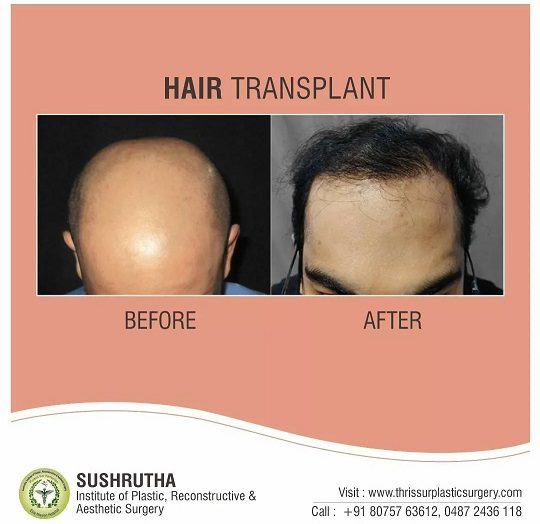HAIR TRANSPLANTATION
Loss of hair can have profound psychological impact on patients. The most common cause is male pattern hair loss which can happen earlier in life and cause the patient to look and feel older. It can affect ladies too. Other reasons can be related to trauma, burns or scarring. Such type of hair loss can be managed by hair transplantation. It is a procedure in which hair along with its roots (called follicles) are removed from one part of the body and transplanted into the deficient area. The transplanted hair grows to give a much more lasting and natural result. Although hair transplant is most commonly done to augment hair on the scalp, some patients also wish to have hair transplant for their eyebrows, beard or moustache if hair are deficient in those areas.
PRP TREATMENT

ABOUT THE PROCEDURE
Your plastic surgeon will assess the cause of your hair loss and degree of hair loss. Also the potential donor areas are assessed. Your general health and well-being is also assessed.If you are medically fit for the procedure, if the hair loss is not due to a systemic illness and if there is adequate donor hair follicles, you will be advised to undergo a hair transplant. It can be done in a single session or over multiple sessions. Thesession lasts almost a day and the patient is sent home at the end of the session.
The donor area is given local anaesthesia and hair follicles are harvested. Usually hair follicles are harvested from the back of the head which are resistant to hair loss, but other regions of the body like the chest can be valuable donor sites too. The harvest can be done either as a strip of hair-bearing skin or as individual follicles. If a strip is harvested then the donor site is closed with stitches while individual hair follicles are harvested from the strip under a microscope by the technicians.
Once the hair follicles are ready then they are transplanted into the bald patches. This is also done under local anaesthesia. The artistry of the plastic surgeon is in creating a natural looking hairline with individual hair follicles implanted at correct angles and in correct density according to the bald area. Hair transplant is an intricate and long surgical procedure which should be undertaken only by a certified surgeon.
RECOVERY AND HEALING
The patient is discharged on the same day. There is usually a little swelling and discomfort for which the doctor would prescribe anti-inflammatory and/or analgesic medications. It is important to prevent infection and hence instructions are given to keep the operated area clean. Antibiotics may be prescribed for a few days. Gentle shampooing is permitted; usually after 2 to 3 days. Minor scabbing is expected and clears off in a few days.
The implanted hair shafts shed off in a few weeks time and new hair start growing from the roots. The results are usually long-lasting but vary from patient to patient. Donor site availability, recipient site requirement, patient’s general health and technique are some of the important variables that influence outcomes.
RISKS
Mild pain and swelling is common after hair transplant but it can be controlled with pain medications. As mentioned earlier crusting can happen which goes away with a few days of gentle washing and cleaning. Shock loss is loss of more hair than transplanted but is usually transient and grows back with time. Scars of the donor area are usually faint and hidden by hair but may be visible if the patient decides to shave off the hair completely.
Severe bleeding and infections are rare but possible. Poor aesthetic outcomes may be seen if the hair follicles are implanted in the wrong orientation and/or density. Improper handling of the hair grafts leading to damage to the hair roots can cause reduction in the density of the transplanted hair. These problems are exceedingly uncommon if the procedure is performed by certified surgeons in a good hospital.

